|
all'installazione dei cookie di ShinyStat modificare opportunamente le impostazioni del proprio browser o cliccare sull'apposito link
|
A.T.A.B.S. Tuscanian Association Bonsai and Suiseki Apreciation
|
Title : A.T.A.B.S.
Internet Address : http://www.bonsaifirenze.com
Language : Italian
|
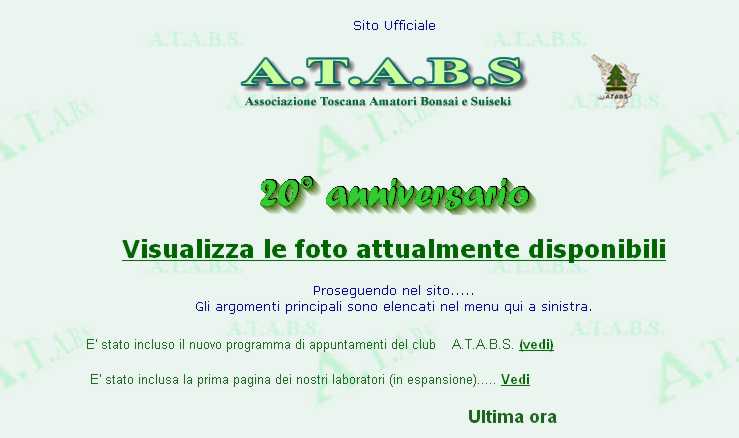 |
|
|
The official website of the Tuscanian Association Bonsai and Suiseki Apreciation : includes the club's activities, practical suggestions, cards of cultivation, pictures, experiences and a section devoted to the suiseki.
|
||
|
The A.T.A.B.S. - Tuscanian Association Bonsai and Suiseki Apreciation
|
||
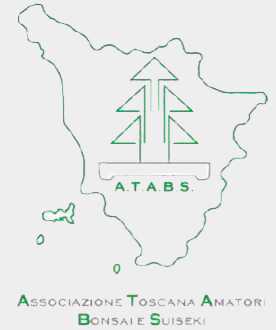 Was Gianfranco Giorgi, Boni Helium, Lorenzo Agnoletti and Umberto Margiacchi, (this last one invited in the final phase) to decide the constitution in 1985 of regional association A.T.A.B.S. to the A.I.B. (Italian Association Bonsai). After the presidency of Gianfranco Giorgi, they are alternates Elio Boni, Paola Gramigni, Massimo Martini and, currently, Sergio Bassi. "A supremacy to which we hold in particular way is that our association from its birth has studied also suiseki. We don't know if since 1985 totally aware choice were one. In fact, the only book of Bonsai then available on the market (the mythical Kenji Murata) hardly spoke about stones evoking landscapes, mountains or islands; however it is an incontrovertible data that some "pebble" always has appeared since ours first exposures. This "supremacy in the name" doesn't want sure to make to come "a de facto supremacy " that after some year brought the Unici di Liguria association to become a suiseki association.
By now from some year, currently in our exposures a specific section dedicated to this particular artistic expression regularly appears. We want to emphasize the main data that represents the role of the association: the great increase of the "medium associate". He has acquired more security in the own abilities, is matured in the taste and in the search of particulars. By now, from some year, the preparation are not improvised but studied in details and guided with sure hand from the more expert associates.
The attention to the Japanese and Chinese culture, never has not been lived like a limit but like an opportunity, with the respect that is right to attribute to the master, without that this means a total cancellation of the own personality."
|
||
|
Suiseki : Viewing stones, and much more
|
||
|
of Sergio Bassi, president of 'A.T.A.B.S.
|
||
|
The atavic tie between man and stones.
Since the man appeared on the earth he has had need stones.
He used them like weapons, like hardware, in order to construct a shelter and in other infinite of ways.
The Suiseki is represented of small dimensioned stones, naturally created.
The evocative power of the suiseki has the ability to evoke insight us images and memories : seen or lived experiences.
A moving stone dismantles our indifference, using also a single point of its force (revealing itself through its shape, color, superficial texture, patina) or, taking advantage itself of all these properties.
Probably the "contemplation and worship of stones" have had origin 2000 years ago in , where small stones where placed on the altars in order to represent islands, legendary mountains, associated to the buddhist or taoiste sideboards.
In the VI° century d.C. some of these stones arrived in
The Japanese adapted this philosophy to their creeds; in recent age, they have created a classification evolved in a continuous update; furthermore they have disclosed this art all over the world, since the enthusiasts are hundred of thousands.
Traditionally the stone is fixed it in a wooden base or footrest that adapted to the contours of the base, or on very low tray with sand or water.
The Suiseki term is the abbreviation of an ancient more complex phrase: SAN SUI JO KEI SEKI that literally means: STONES REPRESENTING NATURAL SCENES OF STONE AND WATER.
During its first period of development, the Suiseki was appreciated both for the beauty and for its philosophical-religious simbolism.
For the Buddhists, the stone symbolizes the Shumi mountain, the sacred mount that the religion places to the center of the world.
For the Taoists, the stone symbolized Horai, the taoist paradise.
For the believers of the philosophical doctrine of the Ying and the Yang, a stone on a tray with water symbolizes the two fundamental forces of the universe: the stone symbolizes the Yang (hard, solid, sand bank, warmth, strong, shining, rough, penetrating) and the water the Ying (gentle, fleeting, humid, cold, dark, mysterious, weak, passive, delicate, sensitive, receptive).
Out of these considerations, the Suiseki is a kind of art and collecting that deeply it going to root in the appreciation of many western peoples, whether appreciators of Bonsai art or not. The Stone arrives to us through traumatic and disturbing transformations during millenia, assuming so perfect and meaningful shapes, such as to leave us unbeliever and full of admiration.
Important Masters asserts:
"So mankind been born in weakness, than this is for the stone. Adaptations and fights with the surrounding atmosphere have formed it. Those who can communicate with a stone develops love for the nature and ability to accept and to survive to the pressures of the life that model to us. The Suiseki enthusiast stretch to being modest, they love the peace and the nature, w’ere aware that nothing can be obtained without sacrifice. Nobody can brail up, nobody e can lie to itself and it must be able to accep the alea of fate."
(M. Paiman President of Indonesian Suiseki Association)
"A beautiful Suiseki brings the observer not only to appreciate the largeness of Nature, but even to understand that which can be defined as the divine creation of the entire Universe and to comprise the beauty of the naturalness.” (Susumu Sudo)
"A finished Suiseki is a treasure. It has the power to make us to remember events of the past, mountains, forests, rivers, cascades, glaciers, clefts. For someone, as it says also the ancient religion Shinto, the Suiseki in full of spirit and divinity. Part of the mystic and the spirit of the Suiseki is in its permanent and moreover ephemeral qualities.
What makes a Suiseki a sublime shape of art, is the knowledge that the development of the aspect has demanded hundred of million years and that still the stone changes its personality second of as is observed in various circumstances." (Felix G. Rivera - Albany - California -U.S.A.)
"Million of years blows off so that it seems that to us on this land crust, always in eternal movement, thin peel of breach, tangling, deeping, elevation. Our Palombini is fractured, welds, cicatrize with calcite belts, with crystallized quartz veins, and still they sink, still they go back, they emerge here and there, finally! Is a long history as only the history of the world knows to be, in it we live those few time that is given living to us, and not always of this we are aware. This history now I have between my hands and it is that I would want to show you: is not a miracle, is not for alea: is the Creation, is LIFE." (Luciana Queirolo - President of Suiseki Club Unici di Liguria - Italy).
|
||
|
Some stones by the Exibition 2005 |
|
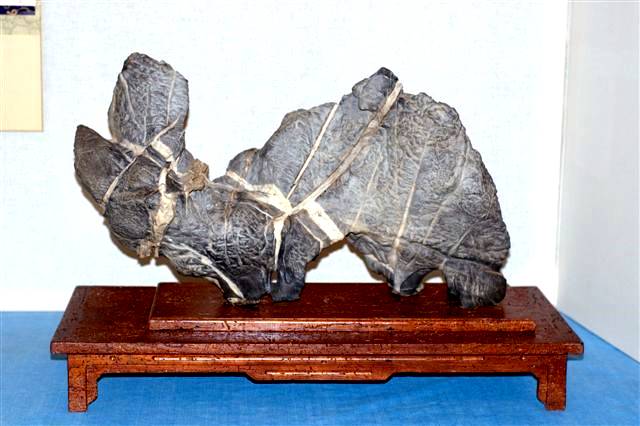 |
|
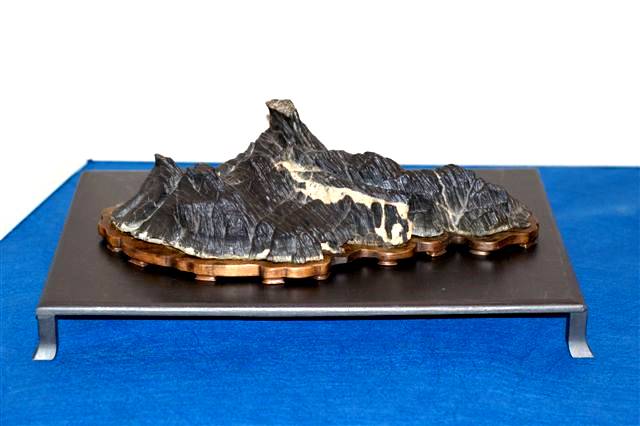 |
|
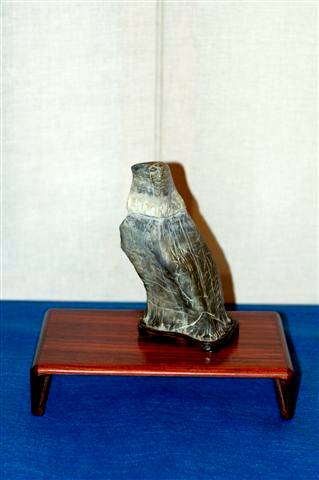 |
|
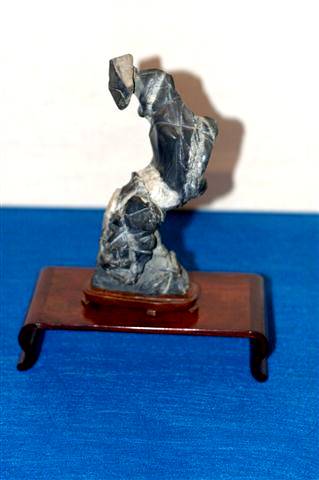 |
|
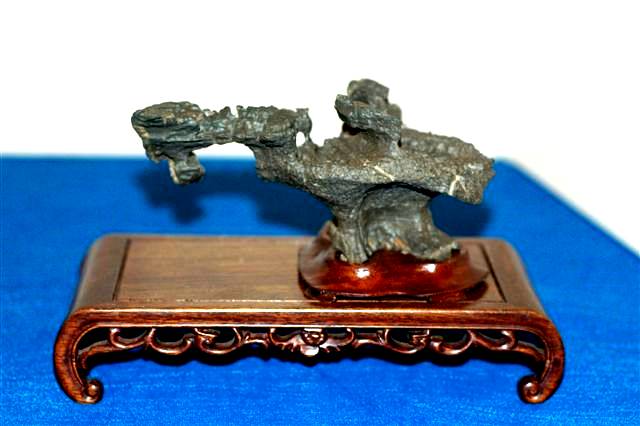 |
|
 |
|
